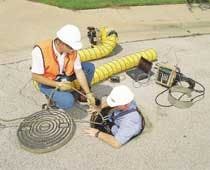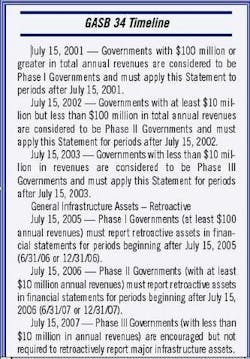By Susan R. McHugh
GASB 34 requirements are dramatically affecting the annual financial reporting process for municipal utilities. At the same time, the new financial report is setting the stage for proactive management of piping networks for water and sewer infrastructure. Sewer System Evaluation Studies will play a key role in the process.
Internal TV inspection is used to determine the exact nature of defects located during smoke testing and physical inspection.
The GASB 34 (Governmental Accounting Standards Board, Statement 34) was issued June 10, 1999, and some aspects of the rule have already gone into effect for large and medium size utilities. The rule requires that municipal, state, and federal governments and authorities report on the value of all capital assets. GASB defines infrastructure assets as "long-lived capital assets, U stationary in nature," (i.e. not vehicles) which can normally "be preserved for a significantly greater number of years than most capital assets."
Typically these include but are not limited to water distribution systems, sanitary sewer collection systems, natural gas systems, electrical distribution systems, and telecommunication/ fiber optics systems that are independent of a single building.
Statement 34 allows two different compliance methods for governments to depreciate their infrastructure assets: a straight-line Depreciation Method or a Modified Approach that takes into account proactive maintenance and repair.
A complete inventory of assets must be compiled, after which agencies can use any reasonable and established method to depreciate an asset's value over the span of the asset's design life. With the standard method, the depreciation can be itemized as an expense on each year's financial statement. This method complies with the requirements for accrual accounting. However, the capitalized value of the asset will decline each year by the amount of the annual depreciation.
Modified Approach
GASB34 recognizes that proactive maintenance and repair of an asset can make a substantial difference in prolonging the design-life of the infrastructure beyond depreciation calculations. To encourage optimized maintenance of infrastructure assets, GASB allows the use of a Modified Approach.
In order to use the Modified Approach, the utility is required to implement an asset management system establishing a minimum condition level for asset categories. The condition assessment must be performed initially and then subsequently every three years. Budgeted maintenance expenses versus actual expenses and any changes in the system's condition must be disclosed annually.
The Modified Approach to GASB34 reporting differs from Depreciation reporting by allowing utilities to:
• Develop and refine an initial condition assessment process.
• Establish minimum performance levels and measures.
• Identify annual maintenance requirements to meet performance goals.
• Develop an on-going assessment and reporting process.
• Implement a Municipal Asset Management (MAM) program.
• Coordinate information with financial reporting activities.
Implementation of a Municipal Asset Management (MAM) program includes:
• Development of an Information Management Platform.
• Collection of valid system condition data to populate inventory and GIS databases.
• Analysis of system capacity and performance conditions.
• Prioritization and projection of capital and cash flow management needs.
• Approaches to repair and rehabilitation or replacement of pipelines and pipeline systems.
Regardless of the method used for GASB reporting, extensive data gathering is the first step a government agency should take towards complying to Statement 34. Comprehensive MAM programs have been developed to provide consulting engineers and municipalities a means to proactively maintain pipeline infrastructure.
By implementing a Sewer System Evaluation Study (SSES) and gathering a detailed asset inventory of the system and assessing pipeline functionality, a sophisticated methodology can be used to evaluate system efficiencies. MAM programs include a core group of processes designed to diagnose, maintain, and support the valuable assets that make up water and wastewater systems. Additionally, a cost analysis is performed to determine the optimum benefits for operation, maintenance and/or replacement.
Municipal Asset Management components include:
• Comprehensive asset inventory
• Sewer system condition assessment and performance evaluation
• Operational strategies
• Maintenance strategies
• Asset replacement strategies
• Investment modeling
• Sewer System Evaluation Tasks
Sewer System Evaluation Studies incorporate physical inspection procedures that establish a complete inventory of the sewer system. Line segments are inspected for condition and defects, length and size. In addition, the lines are inspected to locate sources and volumes of inflow and infiltration that can cause further deterioration of the infrastructure. Existing maps are updated with the defects recorded in the field. Sewer system investigations optimize all aspects of infrastructure performance. The approach to any SSES includes, but is not limited to, the following:
Flow Monitoring — Temporary flow monitoring is used to determine the hydraulic conditions of sanitary sewers under various conditions. Typically conducted over a 60 day period, temporary flow monitoring can be used to determine inflow/infiltration levels, calibrate dynamic hydraulic models, measure in-situ line capacity and detect bottlenecks within the system. Longer duration permanent flow monitoring networks can act as billing stations and can help pro-actively manage wastewater collection systems.
Temporary flow monitoring is used to determine the hydraulic conditions of sanitary sewers under various conditions.
Manhole Inspection — Manhole inspections are performed in order to accurately inventory the assets of the collection system, to update collection system maps and to determine the structural condition of each manhole.
Smoke Testing — Smoke testing will identify inflow sources and most restrictive conditions within the sewer lines.
Line Cleaning and Closed Circuit TV (CCTV) Inspection — Internal TV inspection is used to determine the exact nature of defects located during smoke testing and physical inspection. Using high definition miniature color cameras, the TV operator inspects the interior of sewer pipes looking for defects. Line segments are recommended for inspection when smoke testing indicates main line defects or when temporary flow monitoring indicates hydraulic restrictions
System Mapping — Accurate maps of the sanitary sewer system are critical to the success of maintenance or sewer system evaluation programs. Map correction can provide updated information regarding line and manhole placement and may also locate manholes that could not previously be found.
Rehabilitation Recommendations — Once the initial condition assessment is completed, minimum performance levels are established. Defects found to the infrastructure are rated on a severity basis, allowing governments to identify priority rehabilitation or replacement areas, budget for ongoing methods, and identifying annual maintenance requirements to meet the established performance levels. Appropriate methodologies for rehabilitation are recommended along with estimated costs to allow governments to budget for CIP improvements.
Final Report — The finalized SSES report gives governments the assessment of the infrastructure, thereby giving them the opportunity to develop a realistic capital plan which considers both future system expansion needs and the continued rehabilitation and replacement of the existing system.
In addition to flow monitoring, rainfall analysis, smoke testing, and TV inspection, the SSES may also include flow isolation, dye testing, pump station analysis, and hydraulic modeling, as asset conditions dictate.
With the GASB 34 Depreciation Method of reporting, the value of the asset is depreciated from the original historical cost. Using the Modified Approach allows governments to report all maintenance expenses, if it can be demonstrate that they maintain their infrastructure at an established level, instead of just depreciating the assets.
Regardless of the reporting approach taken, utilities must immediately initiate the development of a GASB 34 compliance strategy. The deadlines for compliance are based on the total revenues of the government and have separate deadlines for new assets placed in service as well as all assets placed in service since 1980. These are being referred to as retroactive assets. There is no deadline for selecting the Modified Reporting approach.
By immediately initiating an SSES, a Municipal Asset Management system, and a CIP for their infrastructure, public entities can demonstrate maintenance of the infrastructure, establish time frames and procedures for rehabilitation, and preserve the assets at a much higher level. A comprehensive sewer system evaluation and storm system audit can identify sources for subsequent rehabilitation, and the data can support that the assets are being maintained at the established level.
Governments will then have the data to formulate a capital planning process that prioritizes capital projects based on such engineering considerations as project cost, need, and system compliance as well as funding source, avoided costs, and impact to the customer base. Additionally, a review of user rates and charges can be performed to ensure the long-term viability of the utility's system revenues. Finally, a review of the utility's current and projected financial position can be realistically configured.
To initiate the development of the best suited compliance strategy, utilities should take the following steps:
• Determine the current commitment level to an asset management system.
• Assess the status of required information and policies.
• Determine any changes required for compliance.
• Develop a phased plan for incorporating the planned capital management strategy.
• Begin implementation and monitoring results.
Conclusion
GASB34 will prove to be a significant change to the financial and operating standards of all capital asset-intensive utilities. The "Modified Approach" to reporting is not only being allowed by the Government Accounting Standards Board, but is being encouraged. The SSES data, used for prioritizing maintenance and repair to prolong the useful life of an asset beyond the basis for calculating depreciation, encourages optimal maintenance of infrastructure assets. Ultimately, governments will be able to manage their assets more cost-effectively and obtain fiscal credit for their efforts.
About the Author: Sue McHugh has over 16 years instrumentation experience, 10 years specifically devoted to the water and wastewater environmental industry. With a background education in Electrical Engineering Technology, McHugh is currently a Business Developer for Severn Trent Services and works closely with municipalities and consulting engineers to evaluate project objectives, development, and planning for ongoing distribution and collection system monitoring, testing, and asset management.




